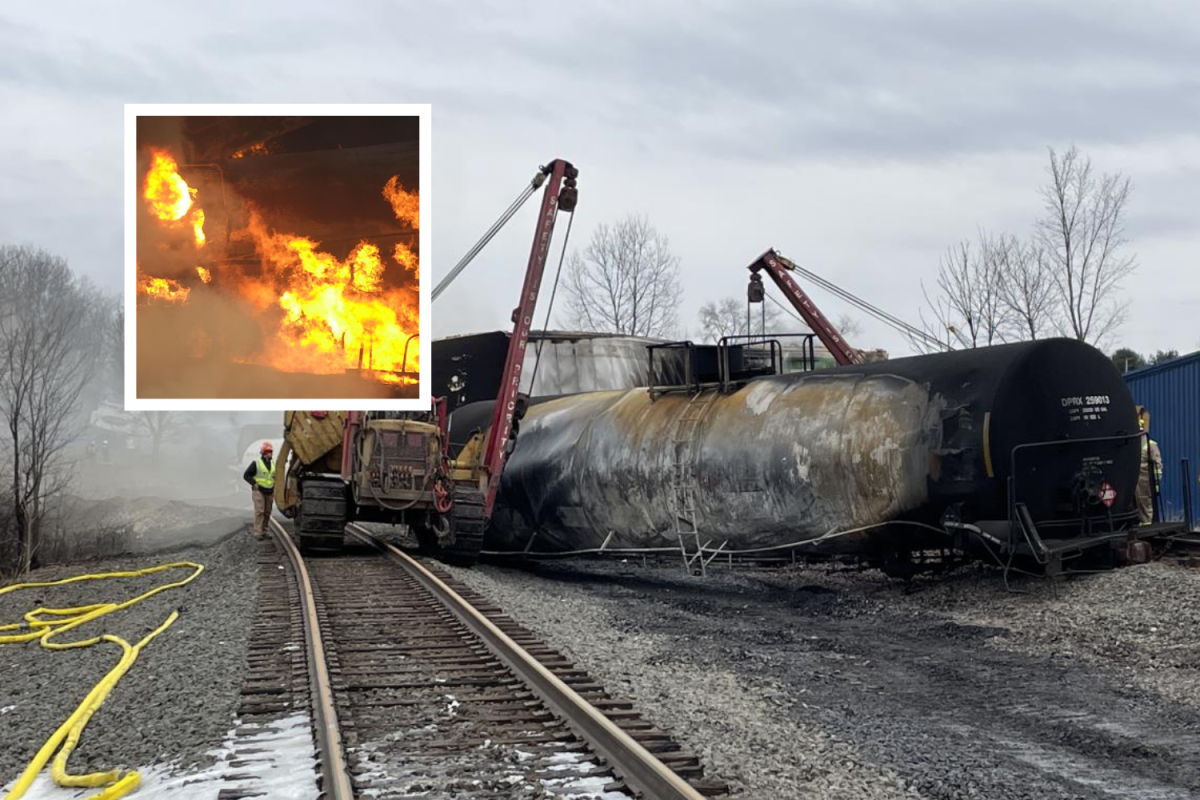Investigation Into Persistent Toxic Chemical Contamination Following Ohio Train Derailment

Table of Contents
The Extent of the Chemical Release and Initial Impacts
The derailment released a significant quantity of hazardous materials, most notably vinyl chloride, butyl acrylate, and ethylhexyl acrylate. These chemicals pose serious risks to human health and the environment. The immediate impacts were dramatic:
- Chemical Release: The exact quantities released are still being determined, but initial reports indicated substantial amounts of vinyl chloride, a known carcinogen, were released and intentionally burned to prevent a larger explosion. Butyl acrylate and ethylhexyl acrylate, both irritants, were also among the released chemicals.
- Environmental Contamination: The immediate environmental impacts were widespread. Air pollution resulted in a noticeable haze and strong chemical odor affecting a large area. Water contamination was a major concern, with fears of leaching into local waterways and the Ohio River. Soil contamination was also significant, requiring extensive testing and cleanup efforts.
- Immediate Health Effects: Residents reported a range of immediate health issues including respiratory problems, headaches, nausea, and eye irritation. The exposure to such a cocktail of toxic chemicals led to widespread anxiety and fear among the community.
- Emergency Response: The initial response involved evacuating residents from the immediate vicinity of the derailment. Emergency services implemented air quality monitoring and provided medical assistance to those affected.
Ongoing Investigation into Persistent Contamination
The Environmental Protection Agency (EPA), along with other state and federal agencies, is conducting a comprehensive investigation into the persistent contamination. This investigation involves extensive testing and monitoring:
- Governmental Investigation: The EPA, Ohio EPA, and other agencies are conducting thorough investigations into the extent and long-term consequences of the chemical release. This includes regular updates and communication efforts to keep the public informed, although trust remains a significant issue.
- Testing Methods: Soil, water, and air quality are being rigorously tested using advanced analytical techniques. Sampling is being conducted across a wide radius to assess the spread of contamination.
- Long-Term Impact Assessment: Assessing the long-term impacts is proving to be a significant challenge. The complexity of the chemical mixture and the potential for long-term health effects necessitate prolonged monitoring and research.
- Epidemiological Studies: Longitudinal epidemiological studies are crucial to understanding the long-term health consequences for the exposed population. This requires tracking the health of residents over many years to identify patterns of illness.
- Government Response Analysis: The government's response has been subject to criticism, with some arguing that the initial response was insufficient and that communication with the affected community could have been improved. Ongoing investigations are examining the effectiveness of the response and potential areas for improvement.
Long-Term Health and Environmental Consequences
The long-term consequences of the Ohio train derailment are deeply concerning and remain largely unknown. The potential impacts are wide-ranging:
- Long-Term Health Effects: Exposure to vinyl chloride and other released chemicals carries a significant risk of long-term health problems, including various cancers and reproductive health issues. Further research is needed to fully assess the extent of these risks.
- Bioaccumulation: The potential for bioaccumulation of toxins in the food chain is a serious concern. Contaminated soil and water could lead to the accumulation of toxins in plants, animals, and ultimately, humans.
- Ecosystem Disruption: The release of toxic chemicals has the potential to disrupt local ecosystems, impacting wildlife populations, plant life, and overall biodiversity. The long-term effects on the local ecosystem are still unfolding.
- Persistent Organic Pollutants (POPs): Some of the released chemicals could be persistent organic pollutants (POPs), meaning they can remain in the environment for many years, posing a continued threat.
The Impact on Local Communities
The Ohio train derailment has had a devastating impact on the local communities. The consequences extend beyond immediate health concerns:
- Economic Impact: Local businesses have suffered economically due to disruptions, evacuations, and decreased tourism. Farmers have also experienced significant losses due to contamination of their land and crops.
- Mental Health: The stress and anxiety experienced by residents as a result of the disaster have had a significant toll on mental health.
- Healthcare Access: Access to adequate healthcare and support for affected residents remains a crucial issue. The ongoing health monitoring and treatment required will place significant demands on the healthcare system.
- Displacement: Some residents may face displacement due to the persistent contamination of their homes and properties. The long-term housing and relocation needs of affected individuals and families must be addressed.
Cleanup Efforts and Future Prevention
Significant cleanup efforts are underway, but the scale of the contamination necessitates a long-term commitment:
- Remediation Strategies: The EPA and other agencies are developing and implementing remediation strategies, including soil removal, water treatment, and other cleanup measures. The effectiveness and long-term implications of these strategies need ongoing evaluation.
- Environmental Cleanup: The cleanup process is expected to be extensive and costly, requiring considerable resources and time.
- Regulatory Changes: The incident has highlighted the need for stricter regulations governing the transportation of hazardous materials and increased safety standards for rail infrastructure.
- Rail Safety Improvements: Improvements to rail safety protocols, including stricter inspections, better tracking systems, and enhanced emergency response plans, are essential to preventing similar incidents in the future.
- Prevention Measures: Investing in safer technologies and implementing more stringent regulations on the transportation of hazardous materials are critical steps to prevent future disasters.
Conclusion
The Ohio train derailment and subsequent release of toxic chemicals highlight the critical need for robust safety measures in the transportation of hazardous materials and comprehensive strategies for addressing environmental contamination. The ongoing investigation into the persistent toxic chemical contamination will be crucial in understanding the long-term consequences and informing future prevention efforts. The long-term health and environmental repercussions of this event underscore the importance of prioritizing environmental protection and community safety.
Call to Action: Stay informed about the ongoing investigation into persistent toxic chemical contamination following the Ohio train derailment. Demand stricter regulations and improved safety protocols to prevent future disasters and protect our communities and environment from the devastating impact of toxic chemical spills. Support organizations working to address the ongoing health and environmental crisis and advocate for stronger regulations to prevent future incidents of toxic chemical contamination.

Featured Posts
-
 Nba And Nhl Round 2 Your Guide To Smart Betting
May 16, 2025
Nba And Nhl Round 2 Your Guide To Smart Betting
May 16, 2025 -
 Sigue En Vivo El Partido Roma Monza Minuto A Minuto
May 16, 2025
Sigue En Vivo El Partido Roma Monza Minuto A Minuto
May 16, 2025 -
 Broadcoms V Mware Deal Massive Price Increase Concerns At And T 1 050
May 16, 2025
Broadcoms V Mware Deal Massive Price Increase Concerns At And T 1 050
May 16, 2025 -
 Resultado Paysandu Vs Bahia 0 1 Resumen Y Analisis Del Partido
May 16, 2025
Resultado Paysandu Vs Bahia 0 1 Resumen Y Analisis Del Partido
May 16, 2025 -
 Stanley Cup Playoffs Nhl Teams Up With Ndax In Canada
May 16, 2025
Stanley Cup Playoffs Nhl Teams Up With Ndax In Canada
May 16, 2025
